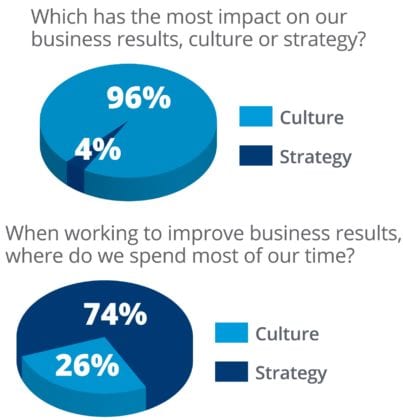Build Culture by Building Habits

By Mattson Newell (@MattsonNewell), a Director for Partners In Leadership who works with leaders to create greater workplace accountability and facilitates enterprise-wide culture change.
Culture vs. Strategy
The effort required to drive culture is often-overshadowed by the quick hits a change in strategy can provide. Leaders can quickly change strategic gears and hire, fire, bonus, incentivize, invest, open, close, re-direct focus and quickly re-shape the strategic focus of an organization. All of these changes can be for naught if you don’t have the right culture in place. As the great Peter Drucker said, “Culture eats strategy for breakfast.” Yet, take a look at the data from a recent Partners In Leadership Workplace Study below:

The majority of leaders spend most of their time on strategy, but readily acknowledge that culture has a greater impact on their business results. So what’s preventing them from working on culture?
 Interested in learning how to build an accountable, solution-oriented culture?
Interested in learning how to build an accountable, solution-oriented culture?
Check out our complimentary live and on-demand webinars.
Operationalizing Culture
Many leaders recognize the effort it takes to create a sustainable, positive culture, yet feel overwhelmed with everything else they have to focus on and see “culture” as just another thing they need to work on.
Louis Gerstner, former CEO of IBM, shared what he learned over his career. “When I came to IBM, I probably would have told you that culture was just one among several important elements in an organization’s makeup and success — along with vision, strategy, marketing, financials, and the like. I came to see, in my time at IBM, that culture isn’t just one aspect of the game, it is the game.”
If culture is the game, how do you go about winning the game? Building it into your game plan, operationalizing it. If culture is a process, then it holds that you would need to embed it into your processes, make it a part of your habits, routines and agendas.
Three areas where culture should be showing up include:
1. Meetings
In team meetings, culture should show up on the agenda in a very specific, actionable way. In industries where safety is a key result and focus area, what do they start every meeting with? A safety moment! The same principle applies to culture: whether sharing a success story around your culture or recognizing someone for living the culture in a specific way, make culture a part of your meetings.
2. Communications
Consistent and deliberate communications across the organization that reinforce culture are vital. We aren’t talking about an initial cultural blitz of communications with posters and email blasts and branded pens (although those have their place). We are talking about consistent communication efforts over time. If the only time your organization hears about culture is when they receive an email from the VP of HR, they will probably see culture as a nice to have, not a must have.
3. Systems
Whether people systems, financial systems or operational systems, there needs to be alignment between our systems and the culture we are looking to create. Systems alignment or misalignment is a significant barrier to culture because people run into our systems every single day. The clichéd example is a sales team trying to drive teamwork and collaboration, yet they are incentivized purely off of their own results.
Like anything in life that is worthwhile, shaping culture requires effort. As you focus your effort on building habits, routines and operationalizing your culture, it will have an impact, not only on engagement and morale, but results. As you focus on managing your meetings, communications and systems it will allow you to manage your culture, instead of your culture managing you.
Mattson Newell is a Director for Partners In Leadership who works with leaders to create greater workplace accountability and facilitates enterprise-wide culture change.
> Read the original article here (links to Inc. Magazine – “Build Culture by Building Habits“)